A great number of you have been asking about the Fujifilm X70’s new digital teleconverter and more specifically, whether it is simply a crop of the 28mm field of view or something more. To answer this question, I thought I would write a brief article ahead of my full review of the camera.
Ethics statement: We purchased the Fujifilm X70 to conduct our full review. We were not asked to write anything about the lens in exchange for the opportunity and were not provided any other compensation of any kind. Within the article, there are affiliate links. If you buy something after clicking the link, we will receive a small commission. To know more about our ethics, you can visit our full disclosure page. Thank you!
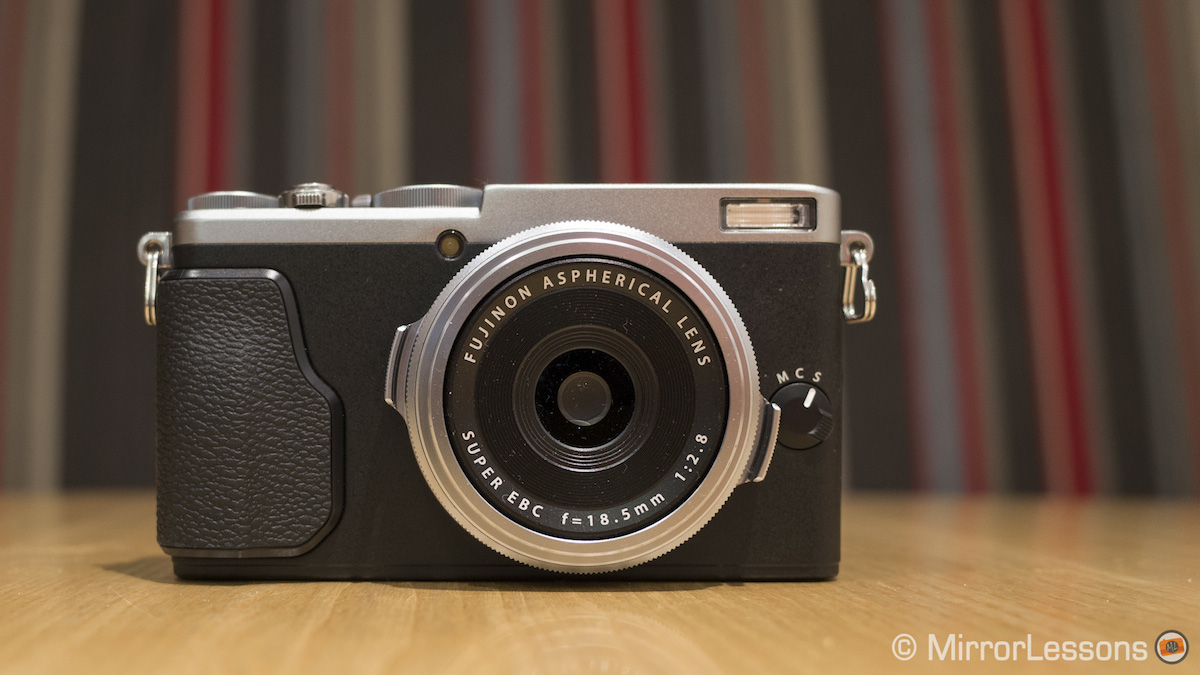
On Fujifilm’s official website, you will find the following statement on the X70 product page:
The image quality may degrade when using the Digital Tele-converter function.
A second explanation is given in the official FujiGuys video (minute 4:55), where it is suggested that the 35mm and 50mm modes give you “full resolution” because of “Fuji’s unique super intelligent digital zoom technology,” or what X-Photographer Jonas Rask refers to as “some clever interpolation and wizardry” in his full review of the camera.
So, judging from these explanations, we can assume two things:
- the digi-teleconverter files will have the same 16MP resolution as the ordinary X70 files, and
- there may be some degradation in image quality
Let’s look at some real world samples to see if this is the case.
The first set of images is of our bookshelf taken at the native 28mm in both JPG and RAW format, as well as the digital 35mm and 50mm in JPG format. (You cannot take RAW files with the digital teleconverter.) All images were taken at f/5.6 at ISO 200. The first thing you’ll notice is that four resulting images do indeed have the same 16 megapixel count (4896 x 3254 pixels).




Next, let’s take a look at four crops (made in post-production) – two taken from the 28mm JPG file at 35mm and 50mm, and two from the 28mm RAW file at 35mm and 50mm – and compare them with the equivalent images produced by the teleconverter. Our goal here is to understand if cropping in post later on gives you the same image quality as the digital teleconverter.
Important note: Since it only makes sense to compare images of the same size, I upscaled the crops to match the resolution of the images produced with the digital teleconverter.




Looking at the images at 100%, I would say that regardless of the field of view (35mm or 50mm), the images produced by the teleconverter are extremely similar to the crops from the 28mm JPGs and RAW files. The 28mm JPG crop does appear marginally sharper and the 28mm RAW crop seems to retain more fine detail but the difference is so small it is barely worth mentioning.
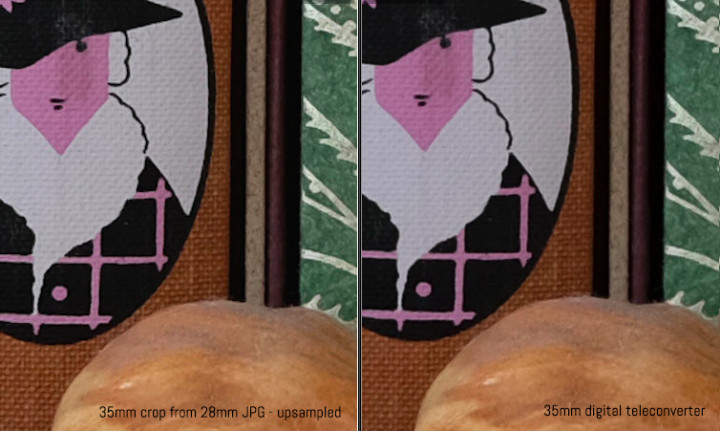
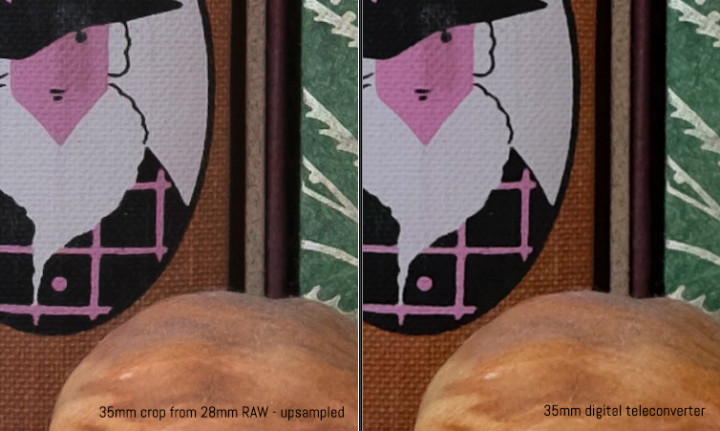
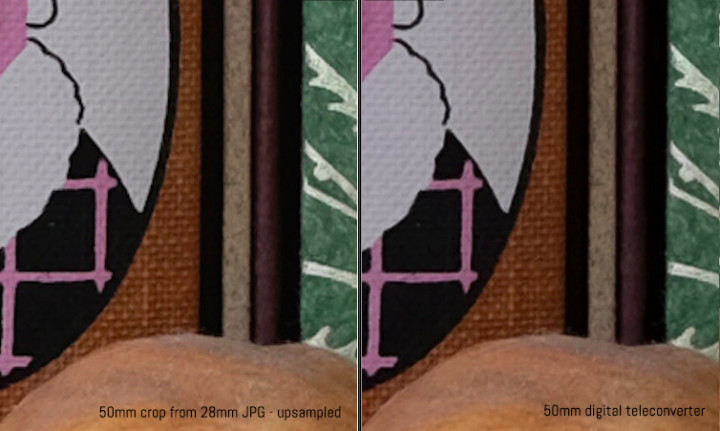
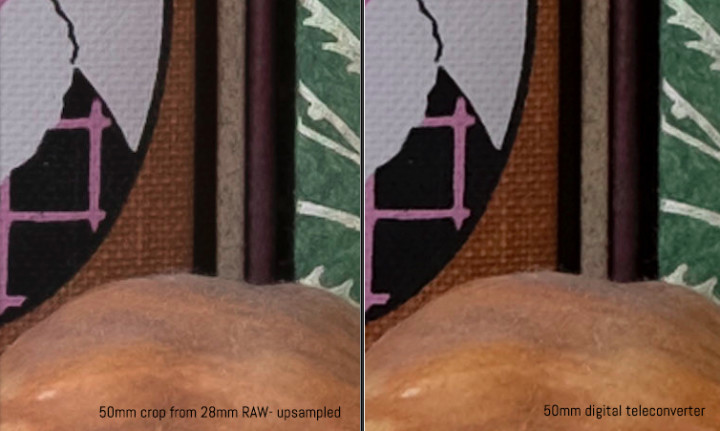
Since bookshelves are a bit dull, I also took a couple more samples for you to download and analyse. The first set is a portrait of Mathieu and the second is a (rather blustery and cloudy) landscape.
Portrait Example
For this set, I’ve once again posted the untouched RAW and JPG taken at 28mm, as well as the two JPGs taken with the digital teleconverter at 35mm and 50mm. Below them you can find two 100% crops that compare the 50mm digital teleconverter image with the 28mm JPG cropped to 50mm in the first set and the 28mm RAW file cropped to 50mm in the second. Both 28mm crops have been upscaled to match the size of the 50mm teleconverter image.
Here as well, you’ll notice that while there is a slight difference in the rendering, the level of detail retention is about the same. However there is some slight aliasing in the 50mm digital teleconverter version (look at Mat’s glasses).






Landscape Example
I performed the same experiment with this landscape shot as well. The main focus point of the image was the white building off in the distance, and as you can see once again, there isn’t a massive difference between the files.




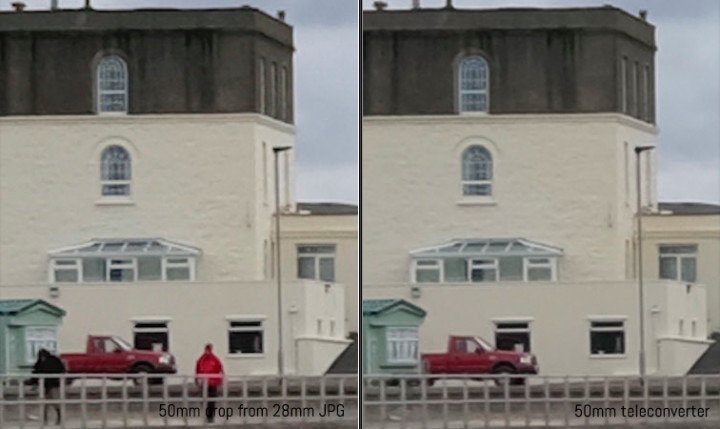

What all this means is that the X70 upscales the image in-camera using image interpolation (and does it quite well I might add).
Of course, the original native RAW file at 28mm will always give you the most flexibility, detail and quality. That said, the digital teleconverter is certainly a handy tool for those who would rather skip the step of reworking their images in post-production.
As always, if you have any questions, feel free to leave us a comment below. (And be sure to check out our full review!)
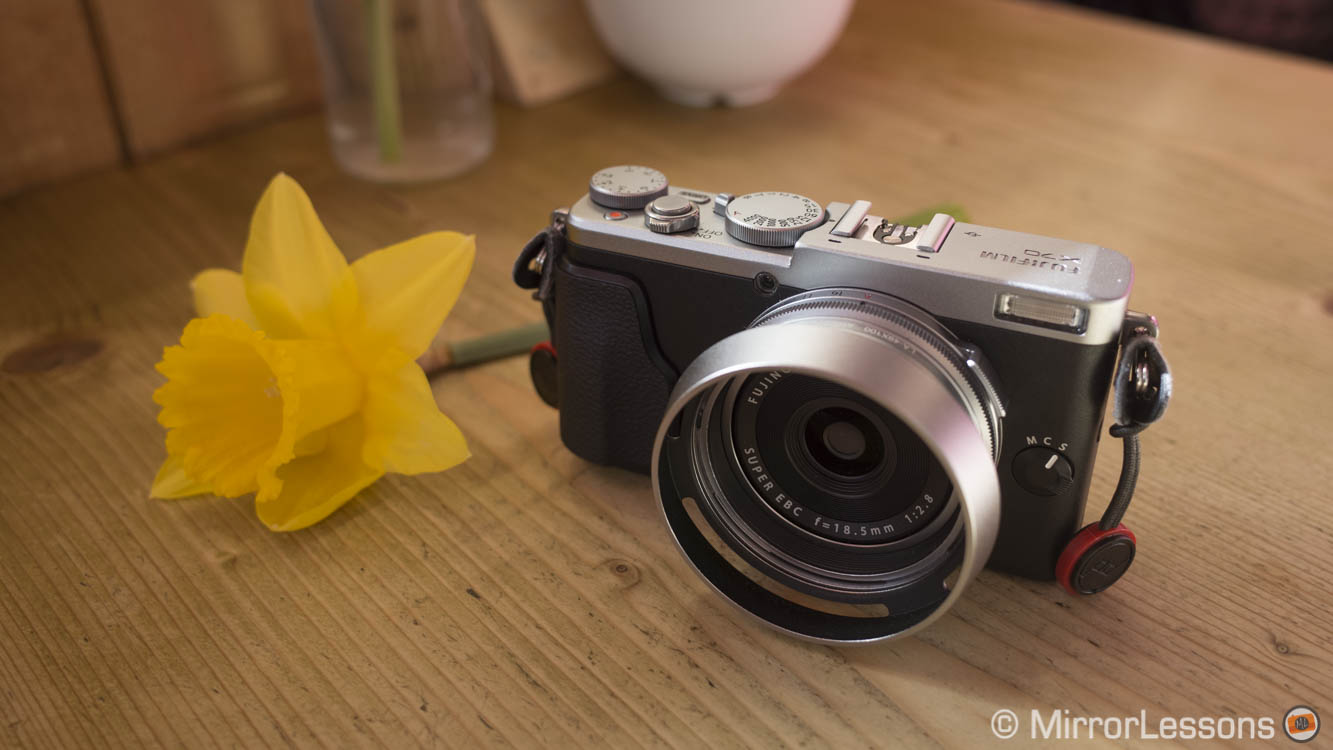
They are not similar at all really. The X100 with the 50mm converter doesn’t lose any sharpness at all. Your also getting the extra subject separation. the x70 digital crop doesn’t compare to the x100 50mm optical teleconverter.
another advantage is the shorter depht of field you have with longer focal lengths that means more blur.
I’ve just got myself the x70 and for some reason I cannot get the settings right to try the crop/ teleconverter to work. Could anyone help me with a step by step instruction please?
useful article.
But can I treat it as a smaller X100 with 35mm lens?
Really, really helpful Heather. Thank you.
I’ve had a look at this because of the new X100F. Derek Clark’s review suggests that with the TCL-X100 (50mm FF) the camera will still give you double zoom out to 100mm equivalent. So both of the conversion lenses can be digitally zoomed too.
If the digital teleconversion holds up as well as the X70, I dare say I’d be happy to push my TCL with a bit of digital zoom (I’m not much of a pixel peeper). It will be very interesting to see how the 24mpx sensor holds up in a similar kind of test. I look forward to more book shots in due course!
Our pleasure!
This is EXACTLY the comparative information I was searching for. Written very clearly and to the point. Thank you!
Very interesting, thank you
One advantage longer lens gives you is added compression of the background that you wouldn’t necessarily achieve by simply cropping a 28mm FOV image. It looks like there is some compression happening with the crop modes, but I’d be curious to see how that might compare to a “proper” 35mm and 50mm lens. I currently have an X100T with teleconverter. I love the combo, but would strongly consider the X70’s pocketable size and its JPEG crop modes if the image quality was similar.
Thank you, Heather!
I don’t have the camera anymore but from what I recall, it was fine except in very bright sunlight. This is actually where the tilting screen comes in handy because you can adjust the angle away from the sun.
Can tell me please if the x70’s display visibility in bright light is good enough ? Thanks !
Thanks, Stefano!
Thanks Heather, great examples and informative comments
Glad you found it useful, Francois!
I don’t really miss it to be honest. The tilting touch screen is enough for most situations.
Sadly, no. We purchased the camera ourselves so we went with the basic package. I’ll see if we can get Fujifilm to send us the VF to test!
I wonder how it would compare to using the X100T with the 50mm teleconverter? Very similar, I guess. To be honest, I’m still waffling between the X100T and the X70 as my next camera. How are you finding not having an optical viewfinder on the X70?
They don’t look half bad! I think the only one I would really use would be the 35mm, but it’s cool nonetheless. The X70 is looking like it might be my next purchase! Any experience with the optional viewfinder?
Heather, great post, very instructive, thanks a lot!